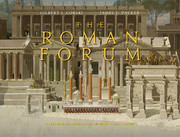Book contents
- Frontmatter
- Map
- Contents
- Preface
- Acknowledgments
- Part I. Architecture in the Roman Forum during the Empire: A Brief History
- Part II. The Monuments
- 3 The Temple of Antoninus and Faustina
- 4 The Temple of Caesar (Aedes divi Iuli)
- 5 The Basilica Æmilia
- 6 The Curia
- 7 The Arch of Septimius Severus
- 8 Minor Monuments
- 9 The Temple of Concord
- 10 The Temple of Vespasian
- 11 The Tabularium
- 12 The Portico of the Dei Consentes
- 13 The Temple of Saturn
- 14 The Basilica Julia
- 15 The Arch of Tiberius
- 16 The Schola Xanthi
- 17 The Diocletianic Honorary Columns
- 18 The Temple of Castor and Pollux
- 19 The Parthian Arch of Augustus (19 BCE)
- 20 The Temple of Vesta
- Part III. Conclusions
- Glossary
- Notes
- Bibliography
- Sources for Coin Images from the Internet and for Other Images
- Index
5 - The Basilica Æmilia
from Part II. - The Monuments
Published online by Cambridge University Press: 05 March 2015
- Frontmatter
- Map
- Contents
- Preface
- Acknowledgments
- Part I. Architecture in the Roman Forum during the Empire: A Brief History
- Part II. The Monuments
- 3 The Temple of Antoninus and Faustina
- 4 The Temple of Caesar (Aedes divi Iuli)
- 5 The Basilica Æmilia
- 6 The Curia
- 7 The Arch of Septimius Severus
- 8 Minor Monuments
- 9 The Temple of Concord
- 10 The Temple of Vespasian
- 11 The Tabularium
- 12 The Portico of the Dei Consentes
- 13 The Temple of Saturn
- 14 The Basilica Julia
- 15 The Arch of Tiberius
- 16 The Schola Xanthi
- 17 The Diocletianic Honorary Columns
- 18 The Temple of Castor and Pollux
- 19 The Parthian Arch of Augustus (19 BCE)
- 20 The Temple of Vesta
- Part III. Conclusions
- Glossary
- Notes
- Bibliography
- Sources for Coin Images from the Internet and for Other Images
- Index
Summary
The Early Republic
During the early Republic, butcher stalls (Tabernae Lanienae) occupied the north side of the Forum, but in the late fourth century, silversmiths’ shops (Tabernae Argentariae) replaced them. As Vitruvius’ famous description of a typical forum suggests, a colonnade may have shaded these shops while balconies and apartments (?) would have occupied the floor(s) above. Behind them stood an early basilica, built probably in 195–191 after a fire had burned through the area some years earlier (210). The fate of this earlier basilica is uncertain, but in 179 Marcus Fulvius Nobilior, one of the two censors (who, among other duties, took care of Rome’s public buildings), let a contract for a basilica “behind the new shops of the silversmiths.” Since Nobilior died the same year, his colleague, Marcus Aemilius Lepidus, completed the structure, which was, therefore, subsequently known as the “Basilica Aemilia and Fulvia.”
In 159, P. Cornelius Scipio Nasica, then also censor, installed a water clock in the building, and in 78 the consul Marcus Aemilius Lepidus decorated its facade with portrait shields (imagines clupeorum). In commemoration of that gift, his son, Lepidus, issued a silver denarius in 61. Since it omits the south shops, it shows either the north facade of the building facing the Macellum (Fig. 5.2) or the interior. The shields in this design appear as decorated frames around portrait busts. To emphasize their importance, they are quite large, completely covering the entablature of the lower order. Judging by the proportions of the later basilica’s decorations, however, they were actually no higher than the frieze. The building on the denarius is two stories high. The lower colonnade is Ionic or Doric/Tuscan, and that above, Ionic (and one-third the size of the colonnade below). Between the columns of both orders, rows of Ionic columns are visible. Upstairs, the larger (outer) colonnade probably stood at the back of a terrace that, on the front facade, overlooked the Forum, and on that in back, the space between the Basilica and the Macellum. The smaller, upper columns on the denarius would thus indicate a second story colonnade around the nave.
- Type
- Chapter
- Information
- The Roman ForumA Reconstruction and Architectural Guide, pp. 91 - 115Publisher: Cambridge University PressPrint publication year: 2015



